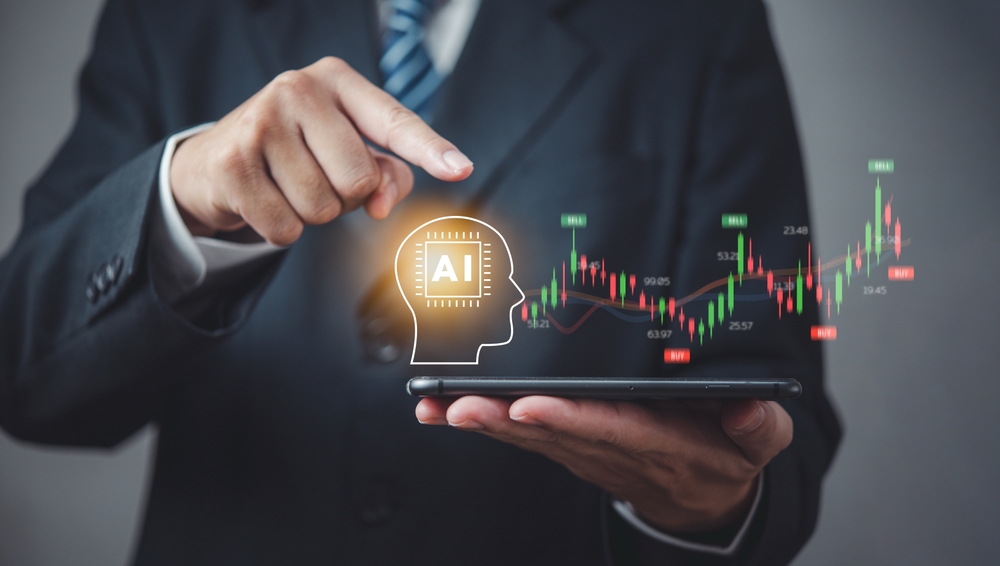How To Leverage AI In Investing For Maximum Returns In 2024
The potential of AI in investing is growing as advanced technologies revolutionize decision-making processes for both professional and individual investors.
Author:Gordon DickersonReviewer:Frazer PughJan 08, 2024866 Shares25.4K Views

The potential of AI in investing is growing as advanced technologies revolutionize decision-making processes for both professional and individual investors.
From highly developed apps like ChatGPT to fully autonomous vehicles, artificial intelligence (AI) is powering a wide variety of modern conveniences. Investing and finance are two areas where financial market AI—often linked with algorithms—is attracting attention.
The potential for generative AI to increase profits by way of the generation of novel ideas and content is attracting a lot of attention. Released in late 2022, OpenAI's ChatGPTbrings cutting-edge generative AI to the masses with its use of advanced language technology to generate massive amounts of text that looks and sounds human.
With the commoditization of traditional investment management differentiators, AI presents new opportunities beyond operational efficiency and cost reduction.
What Is AI?
The goal of artificial intelligence is to have computers act more intelligently than a human being. This manifests in many forms in the actual world.
Machine learning, the most prevalent use of AI, is the process of teaching computers to draw conclusions normally made by humans from data. This sort of AI enables computers to detect certain plant species or visuals, such as faces.
Computer vision and natural language processing are two more popular types of artificial intelligence. Computer vision is essential for applications like autonomous cars, while ChatGPT and other generative AI tools rely on NLP.
Also, there's robotics, which has several uses; for example, industrial robots may paint or weld, and robot vacuum cleaners and other household appliances can clean or serve as security systems.
Last but not least, artificial intelligence (AI) neural networks support technologies like natural language processing and voice recognition by simulating the connections of the human brain.
Investing In The Era Of AI
Over the past few decades, numerous text sources have been subjected to natural language processing (NLP) techniques. These sources include broker analyst reports, corporate earnings calls, regulatory filings, and online news articles. Return predictions can be informed by combining these insights into an aggregate view.
Sentiment analysis, which counts the number of positive and negative words in a document and then assigns a sentiment score based on those counts, was used by early investment signals. Sentence structure and semantics are examples of subtleties that might affect a text's meaning, but these signals ignore them.
Over time, new research advancements like machine learning have increased the level of detail in text analysis. Currently, we're using transformer-based LLMs, which are neural-network designs capable of processing lengthy sequences of elements. These architectures take into consideration the relationship between individual words and zero in on the most crucial points.
Unlike competing approaches, this one doesn't place too much emphasis on nearby words, which means it won't miss meaningful relationships between words that are farther apart. Better investment predictions are possible with the help of transformer-based models, which offer a more exact and accurate interpretation of the text.
Steps To Use AI In Investing
AI in investing journey involves navigating through various tools tailored for both professional and individual investors. To seamlessly integrate AI into your investing or trading endeavors, follow these strategic steps:
- Step 1: Define Your Financial Objectives -Before delving into the world of AI-driven investing, clarify your financial goals. Understanding your investment objectives is paramount in crafting a strategy that aligns with your unique needs and aspirations.
- Step 2: Opt for Your Preferred Investing Approach -Choose between utilizing a robo-advisor, streamlining the process with its AI capabilities, or opting for a hands-on approach to manage investments independently. If leveraging a robo-advisor, its AI technology takes charge of tasks such as assessments, model proposals, and portfolio management.
- Step 3: Formulate Your Investing Game Plan - For those steering their investment decisions, establish a clear investing strategy to define the types of stocks suitable for your portfolio. Alternatively, consider leveraging suggested models from robo-advisors, often available at no cost, to determine an optimal mix of asset classes tailored to your portfolio.
- Step 4: Leverage AI-Powered Investing Tools -If you're actively involved in decision-making, employ stocks screeners as valuable AI tools to aid in selecting individual stocks for your portfolio. Stock screeners typically offer pre-set filters to initiate the process of shortlisting stocks.
- Step 5: Actively Manage Your Portfolio -Once your portfolio is live, leverage automated tools to assist in managing positions and optimizing entry and exit points. Additionally, explore refining your stock screen searches and delve into the application of the efficient frontier to construct a well-balanced portfolio that aims for favorable returns with minimal risk exposure.
Applications Of AI In Investing
Here are a few ways that average investors may use AI into their investment strategies.
Algorithmic Trading
One possible use of AI in the investment industry is algorithmic trading. Artificial intelligence (AI) algorithms allow traders to quickly evaluate massive datasets and trade in response to patterns and trends in the market.
For high-frequency trading, computers have a distinct edge over humans due to their superior data-analysis capabilities. Additionally, AI systems are immune to human biases such as loss aversion, anchoring, and framing.
Taking advantage of price disparities, such as the bid-ask spread, is a common emphasis of algorithmic trading. However, the returns might be so modest that it is only effective in big volume.
Despite the efficacy of algorithmic trading, no trading technique is foolproof since both the market and traders react rapidly to fresh information.
Selecting Stocks
Traders on the U.S. stock market have access to a wealth of information on any company that trades there. The use of AI streamlines the process by which investors may find equities that match their criteria in this mountain of data.
Stock screeners are complex tools that let investors sort stocks according to a variety of criteria, some of which include technical and fundamental data points.
These include, but are not limited to, accounting ratios, market capitalization, trading volume, and moving averages. Check out Zacks (NASDAQ) or one of the many other free stock screeners out there if you're interested in learning the ropes of using one of these platforms.
Portfolio Automation
Wealthfront and Betterment are robo-advisers that streamline the investment process by taking the place of human advisors by automating the steps of helping clients define their investing objectives, time horizon, and risk tolerance.
With the help of an automated portfolio, investors may get a model portfolio that fits their needs by guiding them via a questionnaire.
Along with the questionnaire and model assessment, these platforms also use AI to ascertain the ideal combination of particular stocks for the portfolio. Also, if the chosen portfolio's target allocations deviate too far from the actual portfolio, automated portfolios may be configured to rebalance themselves.
Sentiment Analysis
A further use of AI in the investment industry is sentiment analysis. A number of variables influence market movement, including market mood, interest rates, geopolitical tensions, earnings reports, and macroeconomic statistics.
Even though it's hard to put a number on sentiment, the opinions of investors may have a greater impact on stock market performance than any hard facts.
In order to gauge market mood and foretell future moves, artificial intelligence systems can compile news articles, social network posts, and other online activities.
At the industry level, sentiment may have a major influence, propelling booms in businesses such as EVs, weed, bitcoin, and now AI stocks.
Trade Management
Because of powerful computing power and the capacity to trade markets in near-instantaneous time, brokerage businesses now offer clients very advanced order entry capabilities that enable computers to monitor trade entry and exit.
This order management can get pretty complex, but one use case is when a user wants to buy a stock if it meets a set of criteria. Then, they can use these tools to manage an exit strategy, which could involve a conditional order, like a stop or profitable level, to get out of a position depending on the market's behavior.
If implemented correctly, AI may substantially reduce the emotional component of trading via trade management and trading. Traders and investors should read this article on trading psychology to learn why controlling their emotions is crucial.
Optimizing Portfolio
Optimizing a portfolio is an excellent use of AI. With this tool, investors may choose a portfolio that works for them in terms of their risk appetite and investment horizon.
Even after that, by combining AI with current portfolio theory, one may construct a stock portfolio that is on the efficient frontier, which maximizes returns relative to risk, and so on.
Data Interpretation And Predictions
Making money in the stock market or other asset class is the driving force behind the development of artificial intelligence algorithms that can forecast its future movement. Not every model that uses artificial intelligence to make trading or financial choices is accurate, even if many of them are.
Some active money managers succeed in their attempts to beat broad market indices, while others fail miserably. For instance, you may use AI techniques to detect cycles if you think they occur repeatedly. Artificial intelligence (AI) has the potential to automate the entry and exit of orders based on technical analysis tools.
Risk Management
AI has the potential to enhance risk management by analyzing market data, volatility, and correlations that may impact returns. This analysis can be useful for money managers and companies.
Risk management also makes use of machine learning techniques to cut costs and increase efficiency.
Since the technology can quickly analyze huge datasets with little human intervention, it can replace human labor in some ways.
Additionally, these models can capture nonlinear relationships between risk factors and other variables, and they have shown to be more accurate forecasters than traditional regression models.
Is Investing With AI Safe?
While AI is generally safe to employ, its usefulness in the financial markets is highly dependent on the application's quality and the user's skill level.
The relative safety of an investor's portfolio is dependent on the decisions made by the investor in relation to the risk and reward of individual stocks, as AI technologies for financial markets may be utilized to discover dangerous or safe stocks.
Another foolproof method for picking companies to invest in is to apply contemporary portfolio theory, which may help you build a portfolio that optimizes profits and minimizes risk.
One possible danger of utilizing AI for investing is the possibility of flawed algorithms. Another risk is the possibility of movements caused by several investors using the same AI-generated information.
Best AI Investing Platform
- OKX- Backed by a top-tier crypto exchange, OKX stands out for its support of pre-built bots, serving over 360,000 global traders. With a low-fee policy of just 0.10% per slide, it also provides a marketplace for developers to launch their bots profitably.
- MT5- Offering third-party trading software connecting to numerous online brokers, MT5's MQL5 marketplace lists thousands of AI-backed robots, spanning forex, stocks, gold, cryptocurrencies, and more.
- Capitalise.ai- User-friendly and requiring no coding expertise, Capitalise.ai empowers you to leverage AI for automated trading strategies. Simply provide text prompts to instruct the AI bot, allowing for personalized and intuitive trading.
- Magnifi- A new entrant in the AI trading realm, Magnifi functions as a tool aiding smart investment decisions. Available as an app for iOS and Android, it builds portfolios, suggests strategies, and helps manage risk exposure, connecting to brokers like Robinhood and E*TRADE.
- Trade Ideas- For those seeking a hands-on approach, Trade Ideas introduces Holly AI, its proprietary product analyzing millions of trading scenarios. A premium plan, priced at $228 per month, provides access to Holly AI's insights and suggestions.
- The Trading Analyst- Specializing in options trading signals, The Trading Analyst sends SMS alerts for trading opportunities. Claiming a 20% annual outperformance against market returns, it offers guidance on stock selection and entry/exit points.
- Pionex- Focused on cryptocurrencies, Pionex supports almost 380 markets and serves as an AI trading bot. Offering strategies like grid trading and dollar-cost averaging, it boasts competitive fees at 0.05% per slide.
- QuantConnect- Geared towards advanced traders, QuantConnect operates on the cloud, enabling the building and training of strategies across extensive data points. With high-level backtesting tools, it provides access to over 1,300 liquidity providers.
- Tickeron- Supporting automated trading software across stocks, ETFs, forex, and cryptocurrencies, Tickeron offers diverse strategies. Integrating your Tickeron robot with your brokerage account via an API, prices start from $90 per month, with a 50% discount for annual payments.
FAQs - AI In Investing
How Does AI Impact Investment Decision-making?
AI plays a crucial role in investment decision-making by analyzing vast datasets, identifying patterns, and providing data-driven insights for more informed choices.
What Are The Benefits Of Incorporating AI Into Investment Strategies?
Incorporating AI into investment strategies can lead to improved risk management, enhanced portfolio optimization, and more efficient market analysis, ultimately increasing the potential for returns.
Which Industries Benefit The Most From AI-driven Investing?
Various industries, such as finance, healthcare, and technology, experience substantial benefits from AI-driven investing, leveraging advanced algorithms to gain a competitive edge.
Are There Any Potential Risks Associated With Relying On AI For Investments?
While AI offers significant advantages, potential risks include algorithmic biases, unexpected market behavior, and the need for continuous monitoring to adapt to dynamic market conditions.
How Can Individual Investors Harness AI For Their Investment Portfolios?
Individual investors can leverage AI tools and platforms that provide user-friendly interfaces, enabling them to access automated trading strategies, portfolio management, and data-driven insights to enhance their investment decisions.
Final Words
AI in investing stands as a transformative force, offering innovative tools and strategies that empower investors to navigate financial markets with enhanced precision and efficiency.
Casual investors can now manage their portfolios, make decisions, and trade positions with the help of artificial intelligence, which is transforming the investment industry.
Using AI-based investing tools on current platforms, utilizing third-party AI software, or switching brokers are all viable options for investors.

Gordon Dickerson
Author

Frazer Pugh
Reviewer
Latest Articles
Popular Articles
